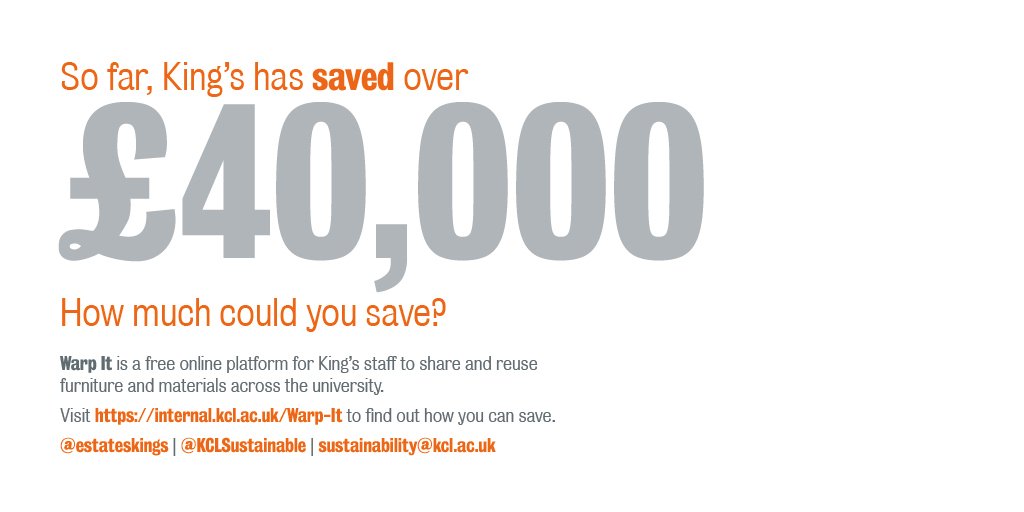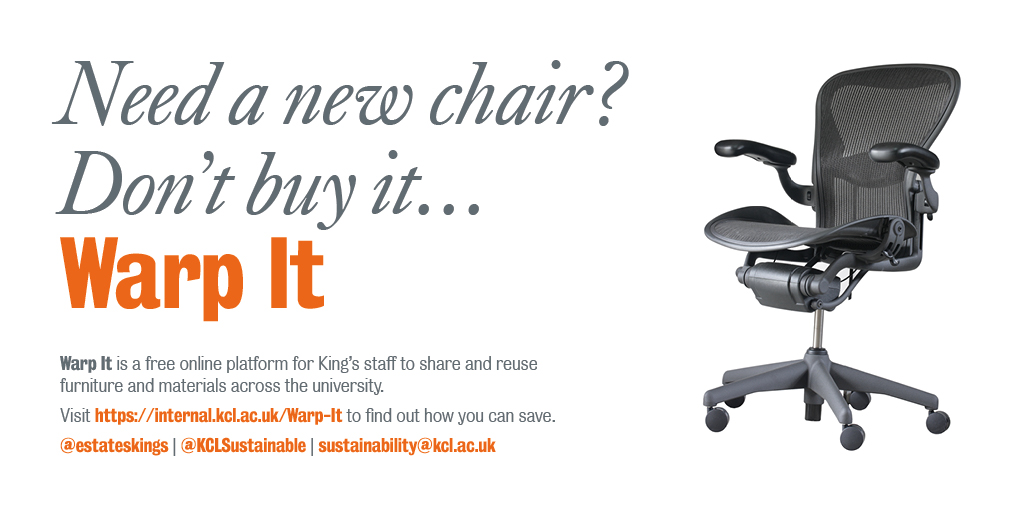We are pleased to be back with another fantastic interview, this time with Tytus Murphy, Sustainability Project Officer at King’s College London. Tytus’ role is part of the Estates & Facilities team, who have been using Warp It since April 2016. One reason we have been so keen to talk to Tytus is that King’s College London have been recording some fantastic reuse statistics.


Savings after 12 months since joining Warp It. To see up to date metrics please see here.
Tytus, what are your personal feelings about reuse at King’s College London?
Extremely positive. I think the key to Warp It is that people buy into it. I think everybody unanimously agrees that chucking out furniture, particularly when it's good quality, is unacceptable and not a good use of research budgets or student tuition fees. So, because avoiding waste is the central message of Warp It, staff at King’s have embraced it. We've got over 350 users and there's probably a third of those who are using Warp It very actively. There's another third who have used it occasionally and there's another third that are aware that the system is there if they need to obtain something, particularly if the budget is tight.
Interesting, and you mentioned buy-in, which we know comes at senior level, staff level and department level. How did you go about getting buy-in for reuse and Warp It?
So, starting at the top end, the head of Estates has been very supportive of this from a financial point of view, and the fact that the metrics that Warp It facilitates show good performance and growth on sustainability outcomes, which is quite unusual. It can be challenging to quantify the benefits in real terms of the actions or policies we’ve enacted as a Sustainability Team, whereas with Warp It, the metrics available enable us to put forward a strong business case for proceeding with this.

Then the sort of level below that would be actually on the ground: resource managers, lab managers and office managers- those who are in charge of the budgets who are typically involved with dealing with the furniture procurement. They've been very supportive.
Our Communications team also put together some excellent posters, which showed how much we were saving, both in terms of waste avoided and financial savings, and we distributed those posters all throughout the Estate in key walkthrough areas that staff members would see. We got a lot of interest from doing that.

Do you think the data and stats played a role in growing the interest in reuse organically? Or were there other factors?
Those numbers were really important as it allows us to say “hey, look! This is working”. People were seeing differences, and that led to interest in the system and new users.

One thing we've had to do is make sure that the process is quite quick and easy to use.
It is great that the Warp It site is very user-friendly, and to back that up we've had to make sure that we're also very quick and efficient in terms of getting items from A to B. And that's not a trivial thing- because we're based in central London, we've got buildings all over the place. So we're continually fine-tuning and improving the process but our major advance has been bringing in the City Sprint courier service to quickly and affordably move items around the university.
That’s true, and it’s something we hear from a lot of our customers, but it isn’t forever. Doing a lot of ground work at the start is a good way to build interest, but over time, as you educate users, and users educate each other, the groundwork phases itself out- and the system runs itself.
Tytus, you mentioned that space is an issue in central London, how do you handle that?
So, that's been a bit of a headache. We're using an underground car park that's not being utilised at all, other than for storage purposes. So we've spoken to our Campus Operations people there and they've given us permission to use it, but there are tight regulations around doing that, so mainly we have to make sure that lots of stuff isn't coming in willy-nilly. Stuff is always going out and we're managing the space pretty effectively so it isn't just becoming a dumping ground and we've done a lot to police that. I've kind of got my eyes on the ground in terms of the porters and some of the maintenance staff. They always let me know whether stuff's been left there or if they need to prevent stuff from being there. In the end, it has worked out quite well.

A better situation is to avoid the need for storage though, right? Is this something you’re working on?
Exactly. Peer-to-peer is the ideal situation but if that doesn't happen, we can then help out. And actually more and more often I'm stepping in after a couple of weeks or after a month, when people need to shift their items thenworking to get it moved over to our central storage. The turnover has been quite good. So actually, I'm in a position now where I can receive stuff and space isn't so much of an issue, but we've had to do a lot to make sure that our storage is well organised. People aren't going in there and dumping stuff or taking stuff. Everything is ID’d and audited, with a reference number too. It’s good content management, and most of the stuff on Warp It I’ve got in this storage space. The active management of items is really important for the system to function.
There’s a couple of other things you can do to encourage a peer-to-peer item network, and one of them is to really get people utilising the wish list function. This prepares people better for the future, so if someone is in the market for a cabinet, and a cabinet becomes available, storage can be skipped and the cabinet can go from A to B.
Indeed. I'm aware that people have used the wish list at King's but I haven’t so done as well with this as I have with following up claims and following up when people post stuff. I know Warp It matches people up as soon as their wish has been fulfilled by a new post. I know that message is sent out, but what I haven't done is make sure that those wishes are still relevant, and so that's something that I need to do. So that's an area that I need to tidy up a little bit. I imagine some of those wishes are probably not so relevant now, so I should touch in with those people.

We’ve introduced a recent update that allows administrators to edit people’s wishlists if items are over three months old. We will be posting about this soon, once we’ve ironed all the kinks out. What we’d like to know is what are the challenges you faced in rolling Warp It out across the estate? Your results have been impressive, so we want to know if anything proved to be a hurdle?
You've got to pick up the phone and meet in person with all of the people that are necessary for this service to work. So, for example, I've presented to Waste Working Groups and had in-person meetings with the people who run our service desk. I've spoken to big stakeholders regarding the central storage place and made sure that their concerns are factored into our processes. Everybody in our Estates Directorate office, including capital projects and space planning are aware that Warp It exists and they know that if they do need something quickly, I can help out. So, it's essentially talking to people, and I've realised this in most of the facets of my life. Email is good, a good website is good, but there is no substitute for phone and in-person discussion when it comes to effective engagement.

Being Mr or Mrs Reuse is something we advise to partners who have one person really driving Warp It, so it’s great to hear this has been successful for you! Is there anyone else who has been particularly helpful or supportive?
Our Head of Procurement. I've met with him in person about this and he's been very supportive. He's given me a list of everybody who's bought furniture in the last 12 months and I've yet to do this, but I can actually email them -most of those names on that list are already on Warp It. Some of them aren't, so there's an opportunity for us to basically say to people who are buying furniture regularly "Hey, here's this system, there's good quality stuff available, please consider using us before going ahead to buy new stuff."
That’s great to hear! We’ve just got a couple more questions for you Tytus. We want to know what, in your opinion, are the biggest drivers for the Procurement Department to get involved in Warp It and reuse?
Ultimately, it's saving costs. It's making sure that money that has already been used to buy assets is not just being used for short-term purposes. You're getting maximum lifespan out of your purchasing, which is an effective use of student fees and research grant income. It's unethical for us to not spend money sensibly in the university. Warp It is a great way for us to ensure that we are being as sensible and efficient with our expenditure as possible, particularly when it comes to furniture, electronic equipment and sometimes even laboratory equipment.

Any final tips for our readers for putting this sort of thing into action on campuses or estates?
I must reiterate, speaking to people. And I think one thing is making sure that somebody has responsibility for Warp It. So, we sort of had a situation where we kicked this off at King's but nobody really took ownership of it and it really has to be part of someone’s job description. Having a dedicated person who approves new registrations, addresses any queries, updates processes, has conversations with and reaches out to different stakeholders is essential to the smooth running of Warp It. Then when that person is away, there has to be somebody else who can sort of support the use of Warp It.
So, we have an exciting situation now where we're actually going to be getting a full-time employee whose major job role will be waste. I became the self-nominated person who looked after Warp It as part of being a Projects Officer. I'm going to be leaving King's in the middle of August. So that ownership of Warp It will go on to this new waste person. So now to the handover- it's all basic stuff but it’s important that any complex process that involves lots of people has a good handover when the person who's maybe developed Warp It moves on.
So, in summary, I have three top tips. The first is "get on the phone, meet people in person." Second one is making sure you've got somebody who's got dedicated responsibilities in their job description, and they've got time to do this, because it does take time. And then thirdly, if that person does move on, there's a really good handover to make sure that all the kind of intricacies have been passed on so that there isn't a breakdown when the person running Warp It moves on.
Wow, great answer Tytus! We wish you all the best for your change of job, and hope that your replacement will continue your fine work with the Warp It system.








